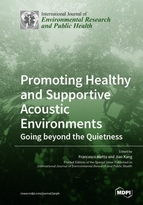Promoting Healthy and Supportive Acoustic Environments: Going beyond the Quietness
A special issue of International Journal of Environmental Research and Public Health (ISSN 1660-4601). This special issue belongs to the section "Environmental Science and Engineering".
Deadline for manuscript submissions: closed (31 March 2019) | Viewed by 105467
Special Issue Editors
Interests: environmental acoustics; soundscape; community noise; noise annoyance; urban planning; environmental design; environmental assessment; landscape design
Special Issues, Collections and Topics in MDPI journals
Interests: environmental acoustics; building acoustics; soundscape; noise control
Special Issues, Collections and Topics in MDPI journals
Special Issue Information
Dear Colleagues,
When confronted with the topic of the quality of the acoustic environments, societies and communities around the world tend to consider “sound” mainly in its negative facet of “noise”. This approach is reflected in a number of recommendations and prescriptions to reduce people’s exposure to excessive sound levels from transportation and industry, promoted by international institutions and authorities, such as the World Health Organization or the European Union. Notwithstanding, such a strategy is not always effective in delivering the desired enhancements in terms of health and quality of life, and this is because “quietness” is not necessarily to define an acoustic environment of high quality. Indeed, environmental sounds often have a positive effect, as they provide information, communicate safety, enable certain desirable activities, and, more generally, contribute to people’s appeasement and psychophysical well-being. With the rapid increase of urbanization, more research is needed towards new approaches for the characterisation, management, and design of urban acoustic environments that support (and not only allow) restoration, health, and better quality of life, as well as basic research on the mechanisms underpinning the perception of environmental sounds in context and how their experience might affect health-related outcomes.
This Special Issue aims to gather contributions related (but not limited) to inter- and trans-disciplinary approaches to the characterisation of the quality of the acoustic environments; perception of acoustic environments, or soundscapes; relationship between acoustic environments and positive health-related effects; new prediction and modelling methodologies for the acoustic environments and their qualities; mapping and monitoring of sound sources in the built environment; and the relationship between sound, space, and behaviour in the built environment. Contributions from a range of disciplines are welcome, including soundscape studies, noise control engineering, environmental design, social sciences, architecture and urban planning, spatial analysis, environmental psychology, epidemiology, and public health.
Dr. Francesco Aletta
Prof. Jian Kang
Guest Editors
Manuscript Submission Information
Manuscripts should be submitted online at www.mdpi.com by registering and logging in to this website. Once you are registered, click here to go to the submission form. Manuscripts can be submitted until the deadline. All submissions that pass pre-check are peer-reviewed. Accepted papers will be published continuously in the journal (as soon as accepted) and will be listed together on the special issue website. Research articles, review articles as well as short communications are invited. For planned papers, a title and short abstract (about 100 words) can be sent to the Editorial Office for announcement on this website.
Submitted manuscripts should not have been published previously, nor be under consideration for publication elsewhere (except conference proceedings papers). All manuscripts are thoroughly refereed through a single-blind peer-review process. A guide for authors and other relevant information for submission of manuscripts is available on the Instructions for Authors page. International Journal of Environmental Research and Public Health is an international peer-reviewed open access monthly journal published by MDPI.
Please visit the Instructions for Authors page before submitting a manuscript. The Article Processing Charge (APC) for publication in this open access journal is 2500 CHF (Swiss Francs). Submitted papers should be well formatted and use good English. Authors may use MDPI's English editing service prior to publication or during author revisions.
Keywords
- environmental acoustics
- community noise
- quiet areas
- soundscape, sound perception
- noise mapping
- noise annoyance
- urban sound planning
- environmental health
- Quality of Life (QoL)
- Quality of Experience (QoE)







